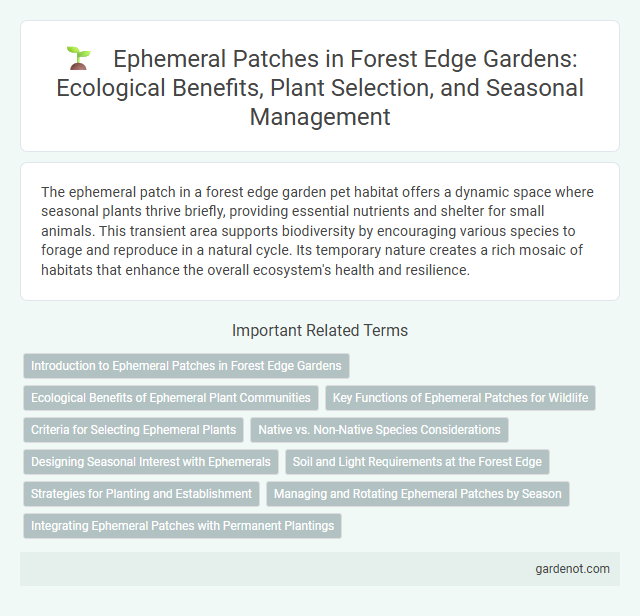The ephemeral patch in a forest edge garden pet habitat offers a dynamic space where seasonal plants thrive briefly, providing essential nutrients and shelter for small animals. This transient area supports biodiversity by encouraging various species to forage and reproduce in a natural cycle. Its temporary nature creates a rich mosaic of habitats that enhance the overall ecosystem's health and resilience.
Introduction to Ephemeral Patches in Forest Edge Gardens
Ephemeral patches in forest edge gardens are temporary zones where early-successional plants rapidly establish, taking advantage of sunlight and nutrient pulses before canopy closure. These dynamic areas support biodiversity by providing specialized habitats for pollinators, ground-nesting birds, and insect communities. Understanding the ecological role of ephemeral patches helps optimize garden design for seasonal growth cycles and habitat connectivity.
Ecological Benefits of Ephemeral Plant Communities
Ephemeral plant communities at the forest edge garden play a crucial role in enhancing biodiversity by providing temporary habitats for pollinators and soil microorganisms. These short-lived species contribute to nutrient cycling and soil stabilization, reducing erosion and promoting forest regeneration. Their seasonal growth patterns also support wildlife feeding schedules, creating dynamic ecological interactions essential for ecosystem resilience.
Key Functions of Ephemeral Patches for Wildlife
Ephemeral patches in forest edge gardens provide critical feeding and breeding habitats for a diverse range of wildlife, supporting increased biodiversity. These transient habitats offer abundant resources such as nectar, seeds, and insects, which are essential for pollinators, birds, and small mammals during specific time windows. By creating microhabitats with varying moisture and light conditions, ephemeral patches contribute to the ecological resilience and connectivity of forest edges.
Criteria for Selecting Ephemeral Plants
Ephemeral plants for a forest edge garden must thrive in partial sunlight and complete their life cycle during brief favorable seasons, typically early spring. Key criteria include rapid growth rates, early emergence before canopy closure, and the ability to reproduce quickly through seeds or bulbs. Choosing native species adapted to local soil moisture and temperature variations ensures ecological harmony and sustainability in the ephemeral patch.
Native vs. Non-Native Species Considerations
Ephemeral patches in forest edge gardens require careful selection between native and non-native species to maintain ecological balance and support local wildlife. Native plants contribute to biodiversity by providing suitable habitats and food sources for indigenous insects and animals, while non-native species may disrupt these interactions and lead to invasive behavior. Prioritizing native species helps preserve soil health and ecosystem stability, ensuring the ephemeral patch thrives seasonally without adverse environmental impacts.
Designing Seasonal Interest with Ephemerals
Ephemeral patches in forest edge gardens highlight seasonal interest by featuring plants with brief but vibrant life cycles, such as spring woodland wildflowers and summer shade-loving annuals. Designing with ephemerals involves selecting species like trilliums, bloodroot, and hepatica, which provide early-season color and texture before the canopy fully leafs out. These plants enhance biodiversity and create dynamic, ever-changing garden landscapes that reflect the natural rhythms of the forest edge ecosystem.
Soil and Light Requirements at the Forest Edge
Ephemeral patches in a forest edge garden thrive in well-drained, nutrient-rich soil with high organic matter content to support rapid growth during their short life cycle. These areas require partial to dappled sunlight, benefiting from filtered light through the forest canopy that prevents soil drying and maintains optimal moisture levels. Soil moisture retention and moderate light exposure are crucial for early spring blooms before tree leaf-out limits sunlight availability.
Strategies for Planting and Establishment
Establishing an ephemeral patch in a forest edge garden requires selecting native early-successional species adapted to fluctuating light and moisture conditions typical of transitional zones. Planting strategies include direct seeding or transplanting seedlings during early spring to maximize growth before canopy closure, ensuring soil preparation promotes drainage and nutrient availability. Regular monitoring and adaptive management, such as selective thinning and invasive species control, enhance patch resilience and biodiversity over time.
Managing and Rotating Ephemeral Patches by Season
Managing and rotating ephemeral patches in a forest edge garden involves adjusting plant placement based on seasonal growth cycles to maximize soil health and biodiversity. Seasonal rotation helps prevent nutrient depletion and controls pest populations by varying plant families in each patch. Implementing a schedule for planting and resting specific areas supports sustainable garden productivity and enhances the overall ecosystem resilience.
Integrating Ephemeral Patches with Permanent Plantings
Integrating ephemeral patches with permanent plantings enhances biodiversity by providing seasonal habitats for pollinators and soil microbes at the forest edge garden. These transient plant communities support nutrient cycling and create microclimates that benefit long-term species. Strategic placement of ephemeral vegetation amidst established perennials promotes ecological resilience and visual diversity throughout the year.
Ephemeral patch Infographic

 gardenot.com
gardenot.com